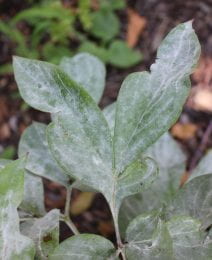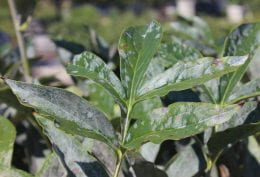By Christian Webb
As summer starts winding down, you may begin to notice some of your bedding plants developing a white powdery coat on the upper surface of their leaves. No, this is not your plants putting on a winter coat for the cool autumn nights. It’s actually caused by the infection of a fungus on the surface of your plants leaves called powdery mildew.

Powdery mildew can be commonly found developing on many types of landscape plants during the late summer. On most plants, this disease will develop on the lower leaves and move up through the canopy. The typically symptoms of the infection will appear as a white to grey dusty growth on the upper surface of the leaves. In severe cases, leave may appear distorted and the cause defoliation.
Pictured to the left: Powdery mildew on Ox-eye Daisy (Heliopsis helianthoides)
To develop, the fungus requires high relative humidity and temperatures around 70⁰F. Many woody and herbaceous ornamentals may be affected by powdery mildew. As a general rule, the powdery mildew on one host will only affect hosts in that genus. For example, the fungi that you will find on oaks trees will only affect oaks and the powdery mildew on grapes will only affect grapes.
If you are looking to control powdery mildew in your landscape, there are a few ways to protect your plants. For annuals, increasing the spacing between plants will increase airflow through the canopy create more unfavorable conditions for powdery mildew develop. Along with altering the plant canopy, consider planting resistant hosts. Replanting the same susceptible hosts will likely result in a reinfection.


Pictured above on left: Powdery mildew on Zinnia (Zinnia elegans). Right: A microscopic image of the powdery mildew spores on the surface of a Zinnia leaf.
There are labeled fungicides for the control of powdery mildew. But you consider apply any product, be sure that your infection is caused by powdery mildew. Downy mildews looks similar to powdery mildew, but are caused by a different type of organism and may not be controlled by products labeled for powdery mildew. Powdery mildew is typically found on the upper surface of the leaf, while downy mildew is associated with the underside of the leaf. For recommended products for the control of powdery mildew, please consult the following factsheet: Link.
For further assistant in identifying powdery mildew, contact your local extension office.
To find your local extension office, the list of Kansas extension offices can be found here.
Further discussion of powdery mildew on woody ornamentals can be found at this Link on pgs. 48-50
Reference:
https://www.fs.fed.us/rm/pubs/rmrs_gtr335.pdf
Powdery Mildew Resistant Peony Varieties
By Kenneth Dodson
Powdery Mildew is a common fungal disease that can appear on a wide range of plants. This year has seen a high level of powdery mildew on peonies, leaving bushes looking snow-covered or dusty. The best way to avoid dusty looking peony bushes is to use resistant plants. A look through the peony demonstration planting at the K-State Gardens showed a wide range of disease susceptibility to powdery mildew.

Pictured above: Powdery mildew on Peony (Paeonia spp.)
Here are a few peony varieties that showed good resistance to powdery mildew. In terms of Herbaceous Peonies: Red Charm, Lillian Wild, and Pink Luau were the best options, followed by Madame de Verneville, and Pink Hawaiian Coral. If you’re looking for Tree Peony varieties, there are several that show strong resistance to powdery mildew: Rockii, Joseph Rock, Kamata Nishiki, Shima Daijin, Hakuo Jishi, Kinkaku, and Kokamon all looked good. Lastly, the Itoh or intersectional peonies Pea Green, Yellow Charm, and Morning Lilac exhibited good disease control against powdery mildew.
Just fyi, the major distinction between the three growing types is the in the way they overwinter. Tree peonies will have a woody stem that stays above ground, while herbaceous peony stems will die back to
the ground every year. Itoh varieties have herbaceous stems as well, and will die above ground, but Itoh peonies typically have the same flowering types as tree peonies.
